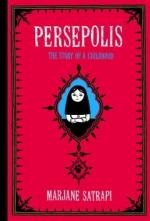|
This section contains 506 words (approx. 2 pages at 400 words per page) |

|
Persepolis: the Story of a Childhood Summary & Study Guide Description
Persepolis: the Story of a Childhood Summary & Study Guide includes comprehensive information and analysis to help you understand the book. This study guide contains the following sections:
This detailed literature summary also contains Bibliography on Persepolis: the Story of a Childhood by Marjane Satrapi.
A major achievement in comics narrative, Marjane Satrapi's first major work Persepolis debuted in France in 2000 to great fanfare. The first two French volumes were translated and reprinted together in the American volume Persepolis: The Story of a Childhood in 2003. Named after the capital city of the Persian Empire, the book is an autobiographical tale set during the Islamic Revolution of Iran and the Iran-Iraq War in the 1970s and 1980s, told through a series of comics. It illustrates how civil strife within the country was as damaging, if not more so, than threats from abroad. Persepolis also dispels the one-dimensional stereotypes of Iran and Iranians, providing a complex picture of life under the regimes of both the Shah of Iran and the Ayatollah Khomeini.
Satrapi's unique position as a descendent of Persian royalty influences the narration, making it less a history and more a memoir in a historical setting. As a child, young Marji learns the history of Iran from family members who participated in important national turning points, enabling her to understand them in an intimate way. Factual details are transformed into details of the heart: how a deposed emperor's son is reduced to a broken man; how a broken marriage weighs more heavily than torture in prison; and how the children of Iran reflect the values of the adults around them.
Satrapi's artistic style is bold and straightforward, evoking the simplicity of childhood drawings and making her work immediately accessible to readers. However, she also uses a range of techniques and styles to capture different moods, alternative perspectives, and dramatic moments. In this way, her story balances the perspective of a child in wartime with the complex politics and morality of the adult world.
There are several kinds of war in Persepolis. The civil disobedience against the Shah of Iran leads to the Islamic Revolution, but the rise of the Islamic Republic government leads to a different kind of oppression that is again met with resistance—albeit in a more subtle, complex form. Satrapi casts a clear eye not only on how the Islamic Republic justifies its exceedingly harsh measures in the name of religion, but on how oppressed people assert their individuality in unexpectedly creative ways. When the war with Iraq starts in 1980, Satrapi notes the strange ways the civil unrest mixes with the national conflict.
Throughout Persepolis, a desire to live life to the fullest, to enjoy what one has even in the worst of times, is an integral concern. Readers witness contraband pop music and family celebrations, school pranks and moments of absurd irony. They also witness torture and propaganda, bombings and execution. This is indeed a very different, more complex image of Iranians: instead of Islamic fanatics who unthinkingly support the Ayatollah, they are a people who defiantly party in the face of political oppression and violent injustice, who know deep pain and suffering as well as ecstatic love and joy. As a child of these times, Satrapi captures the depth and breadth of her Iranian heritage.
Read more from the Study Guide
|
This section contains 506 words (approx. 2 pages at 400 words per page) |

|



